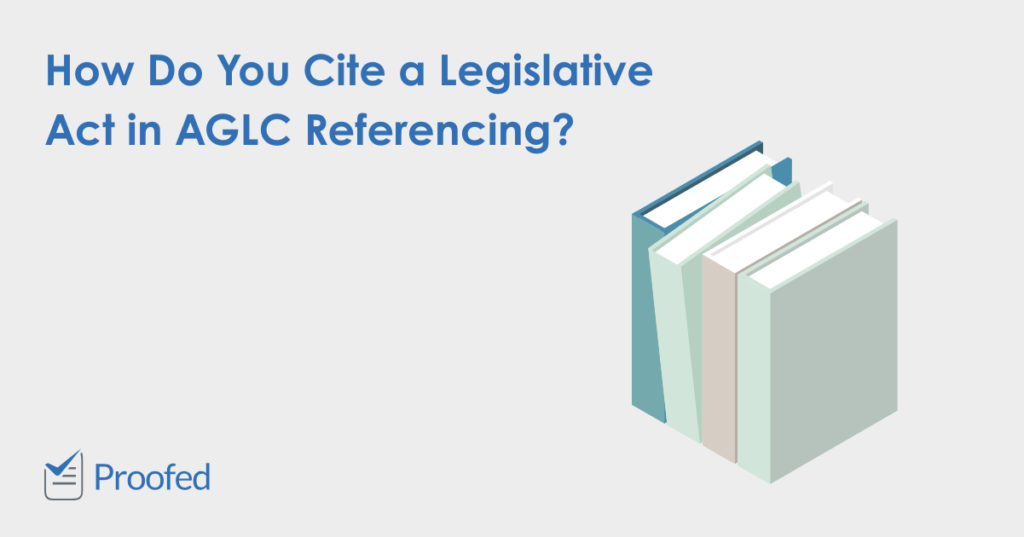If you know much about law in Australia, you should know the term ‘AGLC’ already. It stands for the Australian Guide to Legal Referencing. This book sets the standards for citing Australian legal sources in academic writing, so it’s quite handy to know how AGLC referencing works. Previously, we’ve covered how to cite case reports. Today, we look at citing legislation.
Citing an Act in AGLC
AGLC uses superscript numbers (e.g. 1, 2, 3) to point to footnote citations at the bottom of the page. This is where you provide source details. The information required to cite an Act of legislation is as follows:
|
Short Title of Act |
Year |
(Jurisdiction) |
Pinpoint |
|
Navigation Act |
2012 |
(Cth) |
s 14. |
We can break this down as follows:
- The short title and year are italicised because they stand in for the full title (the long title of the Navigation Act 2012, for example, is An Act relating to maritime safety and the prevention of pollution of the marine environment, and for related purposes, which is a lot more to write out).
- The jurisdiction of the Act goes in brackets. We use ‘Cth’, for example, for all Commonwealth Acts. However, the correct abbreviation may depend on where the legislation was enacted, so make sure to check.
- The pinpoint citation is the exact section of the text you’re citing. You won’t always need a pinpoint citation, but you should give one if you are citing or quoting a specific part of an Act.
This citation format covers most forms of Australian legislation. The other main type of legislation is a ‘Bill’, which we will look at next.
Citing a Bill in AGLC
A Bill is a draft Act of Parliament. The information required here is similar to citing an Act, except we do not need to italicise the short title and year. For example, we could cite a draft version of the Navigation Act as follows:
Find this useful?
Subscribe to our newsletter and get writing tips from our editors straight to your inbox.
1. Navigation Act 2010 (Cth).
It is thus vital to double-check italics when citing legislation.
Subsequent Citations
If you are citing the same source twice in a row in AGLC referencing, you need to use the Latin term ‘ibid’. This means ‘in the same place’, so it points to the source in the previous citation. Make sure to give a new pinpoint citation if you’re citing a different section, though:
1. Navigation Act 2012 (Cth) s 14.
2. Ibid.
3. Ibid s 23.
For non-consecutive repeat citations in AGLC referencing, you will need to use a shortened title plus a cross reference to the first footnote where the source is cited. Typically, you will give the shortened title at the end of the first citation. For instance:
1. Navigation Act 2012 (Cth) s 14 (‘Navigation’).
2. Ruben Stein, Australian Law in Context (Lawbook, 2012).
3. Navigation (n 1) s12.
In the above, we have the full source information in the first footnote, including a shortened title. So when we cite it again in the third footnote, we only have to use the shortened title and a bracketed number to show the reader where the source is first cited. We then give a pinpoint citation to show that we’re citing a different part of the act.
Citing Legislation in the Bibliography
AGLC requires you to list all cited sources in a bibliography at the end of your document. Within this, Acts and Bills should be listed alphabetically under the heading ‘Legislation’.
Entries for Acts and Bills in an AGLC bibliography will be similar to the first footnote citations for these sources. The only differences are that you do not need a pinpoint reference or a full stop. For example, the Navigation Act 2012 would appear simply as:
Navigation Act 2012 (Cth) s 14
We hope that helps you with citing legislation, AGLC style, in your work! But feel free to get in touch if you need help proofreading your document.
